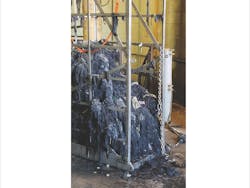TASKMASTER® TM8500: The Flushable Wipe Solution
In 2007, "flushable" wipes were introduced to the market. Disposable wipes have a variety of different uses – from sanitary cleansing to make-up removal. The appeal of disposable wipes is that they are convenient and increasingly popular. They are also often now being labeled as “flushable.”
As the wipes increased in popularity and sales increased, the problem at the pumps increased as well. Unlike toilet paper, wet wipes fail to disintegrate. These wipes are not breaking up in the sewer systems the way ordinary toilet paper does. After the wipes are flushed, they tend to bind and clump together, creating huge balls which get tangled in the pumping equipment.
Blockages occur in residential and municipal sewer systems from accumulations of disposable wipes. The pipes, pumps and other equipment that must process the wipes in wastewater treatment systems are often not capable of handling such waste.
Sewerage authorities and wastewater treatment facilities continue to be challenged by the increasing volume of sanitary wipes. These wipes cause time-consuming bottlenecks, clogging and breakdown of pumps and even cause the back up odorous wastewater into houses. The severity of this problem has received worldwide media attention.
Municipalities and sewer districts report accruing anywhere between $400,000 up to $18 million in costs directly attributable with wipes. So, what can municipalities do to not only combat but overcome this rapidly growing problem? Many municipalities are finding a solution in the installation of grinding and screening equipment.
They have found that by adding grinders in strategic location in the wastewater system, the plugging associated with wipes can be greatly reduced or eliminated. Grinders are being installed at the source, at pump stations or in the wastewater treatment facility, including at the headworks or in locations such as in sludge recirculation lines and at the suction side of pumps.
When wipes build up into mats, mops, balls or large masses, they become an increasingly difficult challenge. According to Korkmaz Oz, Sales Manager of Franklin Miller Inc, a leading manufacturer of wastewater grinders, the key is to prevent wipes from building up into large masses in the first place. Franklin Miller Inc., based in Livingston, NJ., has over 100 years of industry experience and specializes in wastewater grinders.
Franklin Miller developed a range of specialized grinders suited for the particular challenges associates with grinding wipes, providing solutions to the problem for many plants around the country and worldwide. Franklin Miller grinders are proven to reduce pump clogging, protect process and dewatering equipment, reduce solids, and keep wastewater systems running properly. Their grinders are designed for strength and ease of maintenance.
The TASKMASTER® TM8500 grinder features proprietary Cutter Cartridge® technology for superior performance. The Cutter Cartridge has a geometry that has proven optimal for wipes handling. Plus, it combines 6 cutters and 6 spacers into rugged one-piece elements, greatly reducing individual cutter parts and increasing unit strength and reliability. The one-piece element allows a stronger and easier to maintain machine, and easily destroys the problem of wipes.
Franklin Miller’s wipes grinders are available in both pipeline and channel configurations. They can be installed with guide rails for easy removal from a manhole as well fully submersible motors.
Wastewater systems suffer when blockages occur. It’s been a particularly difficult and expensive problem due to woven fabrics build-up, especially from wipes – even those that are labeled as flushable contribute to the growing problem. But the good news is more and more wastewater plants are adapting. They have found that they can keep things moving and get peace of mind, and even some sleep, with a properly designed grinder or screen.
Editor's Note: Scranton Gillette Communications and the SGC Water Group are not liable for the accuracy, efficacy and validity of the claims made in this piece. The views expressed in this content do not reflect the position of the editorial teams of Water & Wastes Digest, Water Quality Products and Storm Water Solutions.
